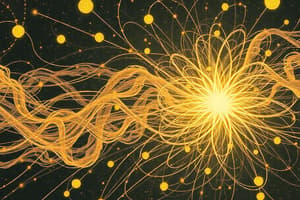Podcast
Questions and Answers
What is the mathematical representation of impulse (J)?
What is the mathematical representation of impulse (J)?
- J = m × v
- J = Fnet / Δt
- J = m × Δv
- J = Fnet × Δt (correct)
What is the relationship between impulse and change in momentum (Δp) of an object?
What is the relationship between impulse and change in momentum (Δp) of an object?
- Δp = Fnet / Δt
- Fnet × Δt = Δp
- Fnet × Δt = m × Δv (correct)
- Δp = Fnet × Δt
In which scenario is the concept of impulse particularly useful?
In which scenario is the concept of impulse particularly useful?
- Analyzing collisions and impacts (correct)
- Analyzing the motion of planets
- Studying the behavior of fluids
- Investigating electromagnetic phenomena
What is the purpose of airbags and seatbelts in vehicles regarding impulse?
What is the purpose of airbags and seatbelts in vehicles regarding impulse?
If an object with mass $m$ experiences a change in velocity $\Delta v$ due to an impulse $J$, what is the mathematical relationship between these quantities?
If an object with mass $m$ experiences a change in velocity $\Delta v$ due to an impulse $J$, what is the mathematical relationship between these quantities?
What is the primary function of arrestor beds?
What is the primary function of arrestor beds?
Which of the following is an example of the impulse-momentum theorem applied in sports?
Which of the following is an example of the impulse-momentum theorem applied in sports?
Which of the following is NOT mentioned as an example of the impulse-momentum theorem in the text?
Which of the following is NOT mentioned as an example of the impulse-momentum theorem in the text?
What is the relationship between impulse and change in momentum, as described in the text?
What is the relationship between impulse and change in momentum, as described in the text?
Which of the following statements is true about the impulse-momentum theorem, based on the information provided?
Which of the following statements is true about the impulse-momentum theorem, based on the information provided?
What is the mathematical representation of impulse in physics, as defined in the text?
What is the mathematical representation of impulse in physics, as defined in the text?
In the impulse-momentum theorem, what does Δp represent?
In the impulse-momentum theorem, what does Δp represent?
How does impulse help in analyzing collisions and other scenarios according to the text?
How does impulse help in analyzing collisions and other scenarios according to the text?
What does impulse represent in one-dimensional motion scenarios?
What does impulse represent in one-dimensional motion scenarios?
What is the significance of airbags and seatbelts in vehicles regarding impulse?
What is the significance of airbags and seatbelts in vehicles regarding impulse?
How is impulse related to changes in momentum according to the text?
How is impulse related to changes in momentum according to the text?
Which quantity connects impulse with change in momentum according to the impulse-momentum theorem?
Which quantity connects impulse with change in momentum according to the impulse-momentum theorem?
In one-dimensional motion, what role does impulse play besides calculating force and time duration?
In one-dimensional motion, what role does impulse play besides calculating force and time duration?
Why is understanding impulse important in analyzing physical scenarios such as collisions?
Why is understanding impulse important in analyzing physical scenarios such as collisions?
What is the role of mass in the impulse-momentum theorem?
What is the role of mass in the impulse-momentum theorem?
How do airbags and seatbelts reduce the force experienced during a collision?
How do airbags and seatbelts reduce the force experienced during a collision?
What is the primary purpose of arrestor beds, as described in the text?
What is the primary purpose of arrestor beds, as described in the text?
Which of the following is NOT mentioned as an application of the impulse-momentum theorem in the text?
Which of the following is NOT mentioned as an application of the impulse-momentum theorem in the text?
What is the mathematical relationship between impulse ($J$), mass ($m$), and change in velocity ($\Delta v$) of an object, as described in the text?
What is the mathematical relationship between impulse ($J$), mass ($m$), and change in velocity ($\Delta v$) of an object, as described in the text?
Which of the following statements about the impulse-momentum theorem is true?
Which of the following statements about the impulse-momentum theorem is true?
What is the primary advantage of applying the impulse-momentum theorem in the design of sports gear and equipment?
What is the primary advantage of applying the impulse-momentum theorem in the design of sports gear and equipment?
Which of the following statements about the impulse-momentum theorem is NOT true, based on the information provided in the text?
Which of the following statements about the impulse-momentum theorem is NOT true, based on the information provided in the text?
Which of the following is an example of the impulse-momentum theorem applied in sports?
Which of the following is an example of the impulse-momentum theorem applied in sports?
What is the primary reason for using force-time graphs in the context of impulse and momentum, as mentioned in the text?
What is the primary reason for using force-time graphs in the context of impulse and momentum, as mentioned in the text?
Which of the following statements about the impulse-momentum theorem is true?
Which of the following statements about the impulse-momentum theorem is true?
If a constant force of 10 N acts on an object of mass 2 kg for a duration of 3 seconds, what is the change in velocity of the object according to the impulse-momentum theorem?
If a constant force of 10 N acts on an object of mass 2 kg for a duration of 3 seconds, what is the change in velocity of the object according to the impulse-momentum theorem?
A baseball of mass 0.145 kg is pitched at a speed of 40 m/s. If the ball is caught by a catcher after traveling 18.3 m, what is the approximate magnitude of the impulse experienced by the catcher's mitt?
A baseball of mass 0.145 kg is pitched at a speed of 40 m/s. If the ball is caught by a catcher after traveling 18.3 m, what is the approximate magnitude of the impulse experienced by the catcher's mitt?
A 60 kg person jumps from a height of 2 m onto a trampoline. If the person's velocity just before landing is 6 m/s, and the trampoline exerts an average force of 3000 N for 0.2 seconds, what is the person's velocity immediately after leaving the trampoline?
A 60 kg person jumps from a height of 2 m onto a trampoline. If the person's velocity just before landing is 6 m/s, and the trampoline exerts an average force of 3000 N for 0.2 seconds, what is the person's velocity immediately after leaving the trampoline?
A 0.5 kg object is initially at rest. If a constant force of 10 N acts on the object for 2 seconds, what is the object's final kinetic energy?
A 0.5 kg object is initially at rest. If a constant force of 10 N acts on the object for 2 seconds, what is the object's final kinetic energy?
A 0.3 kg baseball is hit by a bat and travels a distance of 100 m before being caught. If the ball's initial velocity was 50 m/s and its final velocity was 30 m/s, what was the approximate magnitude of the impulse experienced by the ball during the hit?
A 0.3 kg baseball is hit by a bat and travels a distance of 100 m before being caught. If the ball's initial velocity was 50 m/s and its final velocity was 30 m/s, what was the approximate magnitude of the impulse experienced by the ball during the hit?
A 2 kg object is initially moving with a velocity of 5 m/s. If a constant force of 10 N acts on the object for 3 seconds in the opposite direction of its motion, what is the object's final velocity?
A 2 kg object is initially moving with a velocity of 5 m/s. If a constant force of 10 N acts on the object for 3 seconds in the opposite direction of its motion, what is the object's final velocity?
A 0.2 kg hockey puck is struck by a hockey stick and experiences a constant force of 200 N for 0.01 seconds. If the puck was initially at rest, what is its final kinetic energy?
A 0.2 kg hockey puck is struck by a hockey stick and experiences a constant force of 200 N for 0.01 seconds. If the puck was initially at rest, what is its final kinetic energy?
If a vehicle with mass $m$ experiences a change in velocity $\Delta v$ while traveling through an arrestor bed, which of the following expressions correctly represents the impulse $J$ experienced by the vehicle?
If a vehicle with mass $m$ experiences a change in velocity $\Delta v$ while traveling through an arrestor bed, which of the following expressions correctly represents the impulse $J$ experienced by the vehicle?
In the context of sports equipment design, which of the following statements best describes the role of impulse?
In the context of sports equipment design, which of the following statements best describes the role of impulse?
In a head-on collision between two vehicles, if the impulse experienced by one vehicle is twice the impulse experienced by the other, which statement is true?
In a head-on collision between two vehicles, if the impulse experienced by one vehicle is twice the impulse experienced by the other, which statement is true?
In a force-time graph, which of the following represents the impulse experienced by an object?
In a force-time graph, which of the following represents the impulse experienced by an object?
If a baseball player hits a ball with a bat, which of the following statements is true regarding the impulse experienced by the ball?
If a baseball player hits a ball with a bat, which of the following statements is true regarding the impulse experienced by the ball?
In the design of airbags, which of the following principles is applied to reduce the force experienced by the passenger during a collision?
In the design of airbags, which of the following principles is applied to reduce the force experienced by the passenger during a collision?
Consider a scenario where a vehicle traveling at a constant velocity encounters an arrestor bed. Which of the following statements is true regarding the impulse experienced by the vehicle?
Consider a scenario where a vehicle traveling at a constant velocity encounters an arrestor bed. Which of the following statements is true regarding the impulse experienced by the vehicle?
In the context of seatbelts, which of the following statements best describes their role in reducing the force experienced by a passenger during a collision?
In the context of seatbelts, which of the following statements best describes their role in reducing the force experienced by a passenger during a collision?
In a collision between two objects, if the impulse experienced by one object is three times the impulse experienced by the other object, and both objects have the same mass, which statement is true?
In a collision between two objects, if the impulse experienced by one object is three times the impulse experienced by the other object, and both objects have the same mass, which statement is true?
If a baseball player hits a ball with a bat, and the ball's mass is doubled while keeping the same change in velocity, which of the following statements is true regarding the impulse experienced by the ball?
If a baseball player hits a ball with a bat, and the ball's mass is doubled while keeping the same change in velocity, which of the following statements is true regarding the impulse experienced by the ball?




